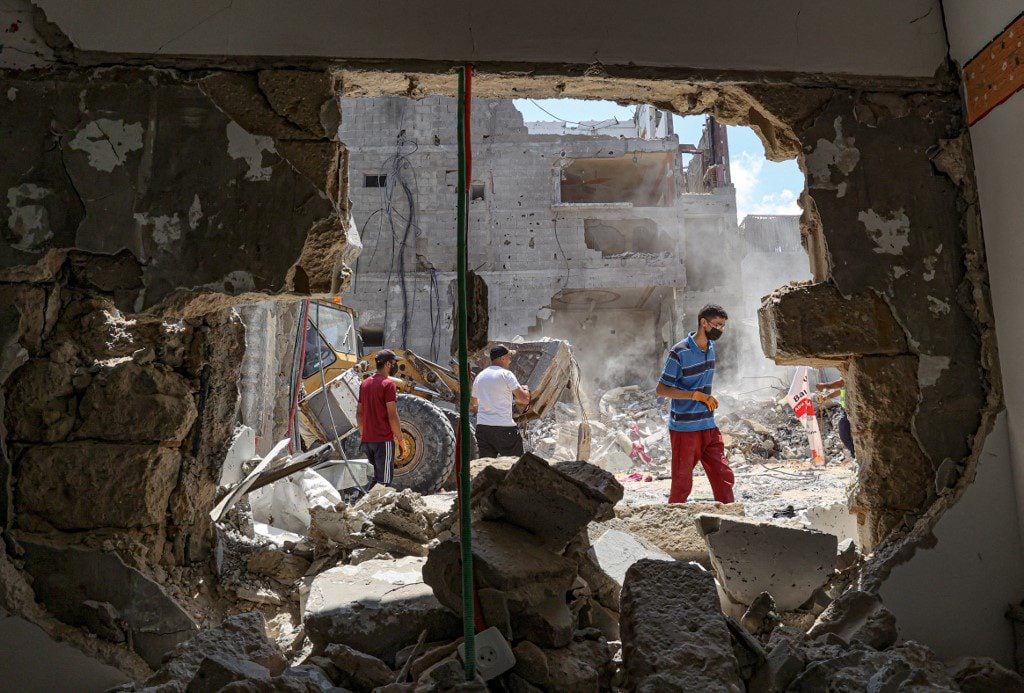
Justin Salhani
Just days after US President Joe Biden ended his Middle Eastern tour by leaving Israel, the Israeli government launched an aerial assault on Gaza. At least 44 Palestinians were killed including 15 children, in the three-day attack, while no Israeli casualties were reported.
The disparity in deaths incurred is directly connected to the imbalance of power in this fight. Israel has the world’s 18th strongest military in the world. The Biden administration requested $3.3 billion in military aid for Israel for 2022 alone. Meanwhile, Gaza has been described by multiple rights organizations as the world’s largest ‘open air prison.’
But the language used by many prominent media outlets gives the impression the bombardment of Gaza is a battle between two evenly matched sides. Israel launched what they described as a “preemptive raid” in August after arresting a senior member of Gaza’s Islamic Jihad militant group. While Hamas sat on the sidelines, Islamic Jihad retaliated with rockets that killed no Israelis.
Instead of noting that Israel launched an attack on an area that is blockaded by land, air and sea, outlets like the AP, the New York Times, the BBC and others framed the story as though one side is not overwhelmingly bombarding the other.
Following the latest ceasefire, AP noted the number of Palestinian deaths while then equivocating how Islamic Jihad’s retaliation, “disrupted the lives of hundreds of thousands of Israelis.”
“Western media coverage routinely labels this situation as ‘complicated,’ portraying this state violence as ‘clashes’ and ‘tensions’ between two sides,” Laura Albast and Cat Knarr wrote in an opinion piece for the Washington Post in April 2022, after Israeli forces attacked worshippers at the Al-Aqsa Mosque.
“Headlines in outlets such as the Associated Press, the New York Times, the Guardian, the Wall Street Journal, NBC News and others use language that fails to recognize the power imbalance between the Israeli military apparatus and the native Palestinian people.”
In some cases, those speaking critically of Israel are swept under the rug entirely. In France, Alain Gresh, the editor in chief of the Middle East focused website Nouveau Orient XXI, was invited to speak on the French channel BFMTV on Israel’s attack on Gaza.
In his appearance, Gresh reminded viewers that Palestinians live under Israeli occupation and that Israel was the aggressor in this conflict. Hours later however, his interview had been removed from BFMTV’s website and an interview scheduled for the next day was canceled.
Many media platforms also uncritically quote Israeli government sources while often entirely overlooking the point of view of many Palestinian experts or commentators. The New York Times, as just one example, reprinted Israel’s claims about the preemptive attack without adding any additional context from Palestinian leaders, journalists, or political analysts who can give a clear eye of the conflict from the Israeli or Palestinian side.
“International media doesn’t trust local sources, organizations, and ministries. Not even local journalists,” Maram Humaid, a Palestinian journalist based in Gaza, told the Nation in an interview from December 2021.
This was most apparent in the aftermath of the murder of Palestinian-American journalist Shireen Abu Akleh. Abu Akleh was shot in the head on May 11th despite wearing protective gear that marked her as a member of the press. Video and witness accounts from the time of the incident pinned Abu Akleh’s murder on Israel’s military. But Israel’s Foreign Ministry put out a tweet blaming Palestinians for her death and the US said the bullet that killed her was too damaged to draw conclusions.
Various media outlets took this disinformation into consideration. CNN eventually released an investigation 13 days after Abu Akleh’s murder on May 24, saying Israel killed Abu Akleh in a targeted attack. On June 28, more than a month after the murder, the New York Times released an investigation saying the bullet “was fired from the approximate location of the Israeli military convoy, most likely by a soldier from an elite unit” and that “16 shots were fired from the location of the Israeli convoy.” Still, the Times was “unable to determine whether the shooter saw that she and her colleagues were wearing protective vests emblazoned with the word ‘Press’.”
But when the fighting is over, the violence against Palestinians does not stop. A 17-year-old Palestinian was shot in the chest and killed, allegedly by an exploding dumdum bullet, in Hebron. The teenager had been attending a protest for three Palestinians killed during an Israeli raid in Nablus. That side of the violence is largely absent however from public discourse.
“You have platforms like the BBC that are absent from reporting on Gaza for long stretches of time, and when they finally decide to interview me, they ignore the siege, the massive problems, and they ask about ‘Why does Hamas prohibit women from smoking hookah?’,” Humaid told the Nation.
The imbalance of power between Israel and people living in the occupied Palestinian territory, particularly under blockade in Gaza, extends to the work of many segments of Western media.
“When Israeli forces raid our neighborhoods in the middle of the night, bomb our children, demolish our homes, colonize our land and kill our people, we are somehow equal instigators,” Albast and Knarr wrote in the Washington Post in April. “Palestinians are not killed; we simply die.”
Media workers are often taught to be objective but, more importantly, to portray the truth. Israeli government sources shouldn’t be disregarded. But their comments and statements should be reported on with the same fervor and fact checking that was given to the Palestinian observers who viewed Shireen Abu Akleh’s murder. In doing so, a more accurate and fair framing of Israel’s occupation of the Palestinian territories and people will come to light.
DISCLAIMER
The opinions expressed in this publication are those of our writers. They do not purport to reflect the opinions or views of Fanack or its Board of Editors.


